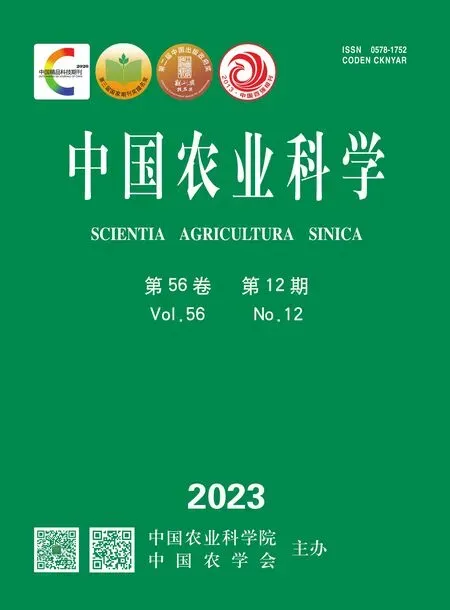长期定位条件下栽培模式对麦田土壤理化性质和氮素平衡的影响
2023-07-09郭鑫虎马静李仲峰初金鹏徐海成贾殿勇代兴龙贺明荣
郭鑫虎,马静,李仲峰,初金鹏,徐海成,贾殿勇,代兴龙,贺明荣
长期定位条件下栽培模式对麦田土壤理化性质和氮素平衡的影响
郭鑫虎1,马静1,李仲峰1,初金鹏1,徐海成2,贾殿勇3,代兴龙1,贺明荣1
1山东农业大学农学院/作物生物学国家重点实验室/农业农村部作物生理生态与耕作重点实验室,山东泰安 271018;2潍坊科技学院,山东潍坊 262799;3南阳师范学院,河南南阳 473061
【目的】基于2009—2010小麦生长季开始设置的长期定位试验,研究栽培模式对土壤理化性质、冬小麦氮素营养指数、麦田氮素供需平衡状况、氮素吸收利用和籽粒产量的影响,以期为进一步优化土壤-作物系统综合管理模式提供理论指导。【方法】试验共设置当地农户模式(T1)、农户基础上的改良模式(T2)、不计生产成本的高产更高产模式(T3)和土壤-作物系统综合管理模式(T4)4个栽培模式。【结果】历经13个小麦-玉米生长季后,T1、T2、T3、T4模式小麦播前容重分别降低6.21%、9.80%、12.25%和13.56%,有机质含量分别提高21.88%、26.80%、32.05%和36.39%,全氮含量分别提高34.16%、12.38%、39.60%和20.79%,碱解氮含量分别提高47.85%、48.87%、74.49%和62.21%,速效磷含量分别提高62.73%、36.56%、297.93%和68.68%,速效钾含量分别提高14.36%、40.00%、221.20%和59.60%。0—100 cm土层无机氮积累量分别提高了33.96%、10.32%、52.77%和19.49%。pH分别从最初的7.50下降至6.28、6.68、5.35和6.64。2020—2022生长季4个栽培模式间籽粒产量和氮素的吸收利用差异显著。与T1模式相比,T2、T3、T4模式的籽粒产量分别提高14.14%、27.65%、22.52%,氮素利用率分别提高54.80%、19.97%、49.15%,氮肥利用率分别提高72.95%、37.54%、48.15%,氮素表观损失量分别降低49.76%、11.62%、44.14%,氮素表观损失率分别降低24.63%、11.62%、26.68%。T4模式开花期的整株和成熟期的穗子处于氮素供需平衡。【结论】历经13个小麦-玉米生长季后,4个栽培模式0—20 cm土层土壤酸化趋势明显,表层土壤容重降低,有机质、全氮、速效氮磷钾养分含量升高,0—100 cm土层无机氮积累量相应升高。与其他3种模式相比,T4模式更有利于实现土壤理化性状、小麦籽粒产量和氮素吸收利用的协同改善,但其氮肥利用率仍有待进一步提高,且在现有基础上仅通过降低施氮量无法实现其产量和氮素吸收利用的进一步协同优化。
土壤理化性质;小麦籽粒产量;氮素利用率;氮素营养指数;氮素平衡
0 引言
【研究意义】近年来,土壤-作物系统综合管理被广泛用于提高粮食作物产量和养分利用效率,同时减少环境污染[1-3]。本课题组以协同提高小麦产量和氮素利用效率为目标,在系统开展种植密度、播期、氮肥用量、播种方式等单因子和互作效应研究的基础上[4-11],从2009—2010年小麦生长季开始设计和构建了4种综合管理模式,即当地农户模式、农户基础上的改良模式、不计生产成本的高产更高产模式和土壤-作物系统综合管理模式。其中,土壤-作物系统综合管理模式以宽幅密植、减量施氮和适当延后播期为显著特征。与此同时,与其他课题组合作,开展了小麦-玉米周年高产高效土壤-作物系统综合管理模式的构建和研究。【前人研究进展】相关的研究表明,土壤-作物系统综合管理的应用利于实现作物产量、资源利用效率和经济效益的协同提高[12-16],可在减少21.39%的氮肥投入量的基础上,较农户习惯模式提高小麦-玉米周年产量33.56%[17]。历经13个小麦-玉米生长季,实现了小麦产量较当地农民习惯模式平均提高22.52%,麦田氮素利用效率平均提高49.15%的效果。【本研究切入点】长期定位条件下,土壤-作物系统综合管理无疑会对麦田土壤肥力性状和氮素供需平衡状况产生显著的影响。明确这种影响的性质、方向和大小,对于构建与变化后的土壤肥力相适应的土壤-作物系统综合管理模式具有指导意义。【拟解决的关键问题】基于13个小麦-玉米生长季的长期定位试验,系统研究不同栽培模式对土壤理化性质、小麦氮素吸收利用、植株氮素营养指数、麦田氮素供需平衡状况和籽粒产量的影响,以期为进一步优化土壤-作物系统综合管理模式,在更高水平上实现小麦籽粒产量和氮素吸收利用的协同提高提供理论指导。
1 材料与方法
1.1 试验点概况
长期定位试验田位于山东省泰安市大汶口镇东武村(35°57′N,117°3′E),该地区属温带大陆性季风气候区,年均日照时间2 627 h,≥10 ℃年积温4 213℃,年均无霜期195 d,年均降雨量697 mm,但多集中于6—9月,近40年小麦生长季平均降雨量为188.31 mm。种植制度为冬小麦(L.)-夏玉米(L.)轮作,一年两熟,土壤质地为粉砂壤土。
1.2 试验设计
以大穗型冬小麦品种泰农18为供试材料,设置4种栽培模式,分别为当地农户模式(T1)、农户基础上的改良模式(T2)、不计生产成本的高产更高产模式(T3)和土壤-作物系统综合管理模式(T4)。T1模式为冬小麦播前玉米秸秆旋耕还田,夏玉米免耕播种+小麦秸秆覆盖,其他3种模式为冬小麦播前玉米秸秆翻耕还田,夏玉米播前旋耕+秸秆还田。采用水表和微喷带精确灌溉,每次灌水量为70 mm,其中T1模式在播种后、越冬期、返青期、开花期、花后15 d灌水,其他3种模式在播种后、拔节期、开花期和花后15 d灌水。各栽培模式的播期、种植密度和肥料运筹详见表1,其他管理措施和高产麦田一致。试验采取随机区组设计,每个栽培模式设置4个重复,小区面积为240 m2(40 m×6 m)。以13个生长季的长期定位试验为研究平台,于2020—2022年设置小区面积为60 m2(10 m×6 m)的不施氮小区以计算各模式的净矿化量和氮肥利用率。

表1 4种栽培模式的种植密度、播期和肥料运筹
T1:当地农户模式;T2:农户基础上的改良模式;T3:不计生产成本的高产更高产模式;T4:土壤-作物系统综合管理模式。R:冬小麦返青期;J:冬小麦、夏玉米拔节期;VT:夏玉米抽雄期;VT7:夏玉米抽雄后7 d。下同
T1: local farmer mode; T2: farmer-based improvement mode; T3: high-yield and higher-yield mode regardless of production cost; T4: soil-crop system integrated management mode. R: Regreening stage of winter wheat; J: Jointing stage of winter wheat or summer maize; VT: Tasseling stage of summer maize; VT7: 7 days after tasseling stage of summer maize.the same as below
1.3 测定项目与方法
1.3.1 土壤理化性质 于冬小麦播前采用环刀法测定0—20 cm土层土壤的容重。用土钻在每个小区取5点,取0—100 cm土层土壤(20 cm/层),剔除石砾和植物残根等杂物后混匀过10目筛,将0—100 cm土层土壤保存于-20 ℃的冰箱中待测无机氮(铵态氮与硝态氮),另取播前0—20 cm土层土壤测定有机质、全氮、碱解氮、速效磷、速效钾含量和pH等理化指标,具体测定方法详见《土壤农业化学分析方法》[18]。
1.3.2 地上部氮素积累量 分别于冬小麦的返青期和拔节期取30株长势均匀的整株,于开花期、花后15 d、花后25 d和成熟期取30个长势均匀的单茎。将花后各期所取单茎分为茎、叶和穗器官(除开花期为整个穗外,其他时期将穗子分为籽粒和颖壳+穗轴两部分)。105 ℃杀青30 min后,75 ℃烘干至恒重然后称重。称重后的植株和器官采用微型植物粉碎机粉碎,然后采用半微量凯氏定氮法测定全氮,各器官的干重与氮素含量的乘积为地上部氮素积累量。
1.3.3 氮素供需平衡 根据氮平衡原理计算氮素表观损失量[19],氮输入包括施氮量、播前0—100 cm无机氮积累量和净矿化量3部分,氮输出包括成熟期地上部氮素积累量、成熟期0—100 cm无机氮积累量和氮表观损失量3部分,其中净矿化量在不考虑氮肥激发效应情况下通过不施氮小区计算而得。
无机氮积累量(kg·hm-2)=土层厚度(cm)×容重(g·cm-3)×无机氮含量(mg·kg-1)×0.1;
氮净矿化量(kg·hm-2)=不施氮小区地上部氮素积累量(kg·hm-2)+不施氮小区成熟期0—100 cm无机氮积累量(kg·hm-2)-不施氮小区播前0—100 cm无机氮积累量(kg·hm-2);
氮表观损失量(kg·hm-2)=施氮量(kg·hm-2)+播前0—100 cm无机氮积累量(kg·hm-2)+净矿化量(kg·hm-2)-成熟期地上部氮素积累量(kg·hm-2)-成熟期0—100 cm无机氮积累量(kg·hm-2);
氮表观损失率(%)=氮表观损失量(kg·hm-2)/施氮量(kg·hm-2)×100。
1.3.4 氮素吸收利用和氮素营养指数 氮素吸收利用的相关指标参考初金鹏等[20]的计算方法。
土壤供氮量(kg·hm-2)=施氮量(kg·hm-2)+播前0—100 cm土层土壤无机态氮积累量(kg·hm-2);
氮素利用率(kg·kg-1)=籽粒产量(kg·hm-2)/土壤供氮量(kg·hm-2);
氮素吸收效率(%)=成熟期地上部氮素积累量(kg·hm-2)/土壤供氮量(kg·hm-2)×100;
氮素内在利用效率(kg·kg-1)=籽粒产量(kg·hm-2)/成熟期地上部氮素积累量(kg·hm-2);
氮肥利用率(%)=(施氮小区植株地上部氮累积量(kg·hm-2)-不施氮小区地上部植株氮累积量(kg·hm-2))/施氮量(kg·hm-2)×100。
氮素营养指数(nitrogen nutrition index,NNI)为实际氮浓度(Na,%)与临界氮浓度(Nc,%)的比值[21],当NNI>1时,说明氮供应盈余;当NNI<1时,说明氮供应亏缺;当NNI = 1时,说明氮素供需平衡。临界氮浓度的计算公式随着生育时期的推进有所不同,冬小麦开花期前关注整株的营养状态,采用公式(2)[21-22],开花期后关注穗子的营养状态,采用公式(3)[23],开花期则分别计算整株和穗子的氮素营养状态。
NNI = Na/ Nc(1)
Nc= 5.35 × WP-0.44(2)
Nc= 2.85 × WE-0.17(3)
式中,WP为单位面积冬小麦地上部的干物质重(t·hm-2);WE为单位面积冬小麦的穗重(t·hm-2)。
1.3.5 冬小麦籽粒产量 于冬小麦成熟期在长势均匀的区域划出2 m×1.5 m的小区,将小区内的麦穗全部收割,风干后脱粒并称重,用谷物水分分析仪测定实际含水量,将其含水量调整为13%得到籽粒产量。
1.4 数据处理与统计
数据的整理与分析采用Microsoft Excel 2010和DPS 7.05,差异显著性检验采用LSD法进行,图表的绘制采用SigmaPlot 10.0和Microsoft Word 2010。
2 结果
2.1 栽培模式对冬小麦播前土壤理化性质的影响
2020—2022年生长季小麦播前测定结果显示(表2),历经13个小麦-玉米生长季后,4种栽培模式0—20 cm土层的土壤容重均显著降低,T1、T2、T3、T4模式分别比2009—2010年生长季小麦播前降低6.21%、9.80%、12.25%和13.56%。4个模式间相比较表现为T1>T2>T3>T4,与T1模式相比较,T2、T3和T4模式分别下降3.83%、6.45%和7.84%。与此同时,0—20 cm土层土壤pH均呈现出明显酸化趋势,T1、T2、T3和T4模式的pH分别从最初的7.50下降至6.28、6.68、5.36和6.64,其中T3模式酸化程度最严重。
历经13个小麦-玉米生长季后,小麦播前0—20 cm土层的有机质、全氮、碱解氮、速效磷和速效钾含量均显著提高,T1、T2、T3、T4模式的土壤有机质含量分别提高21.88%、26.80%、32.05%和36.39%,全氮含量分别提高34.16%、12.38%、39.60%和20.79%,碱解氮含量分别提高47.85%、48.87%、74.49%和62.21%,速效磷含量分别提高62.73%、36.56%、297.93%和68.68%,速效钾含量分别提高14.36%、40.00%、221.20%和59.60%。
4个模式土壤有机质含量从高到低的排序为T4>T3>T2>T1。T2、T3、T4模式的表层土壤有机质含量分别比T1模式高4.03%、8.34%和11.90%。全氮含量的排序为T3>T1>T4>T2。T2、T4模式的全氮含量分别较T1模式低16.24%、9.96%,T3模式则高4.06%。碱解氮含量表现为T3最高,T4次之,T1和T2最低。T2、T3、T4模式碱解氮含量分别比T1模式高0.68%、18.02%和9.71%。速效磷含量表现为T3最高,T4和T1次之,T2最低。T3、T4模式速效磷含量分别较T1模式高144.54%和3.84%,而T2模式降低了16.08%。速效钾含量表现为T3>T4>T2>T1。与T1模式相比较,T2、T3和T4模式的速效钾含量分别增加22.42%、180.86%和39.56%。
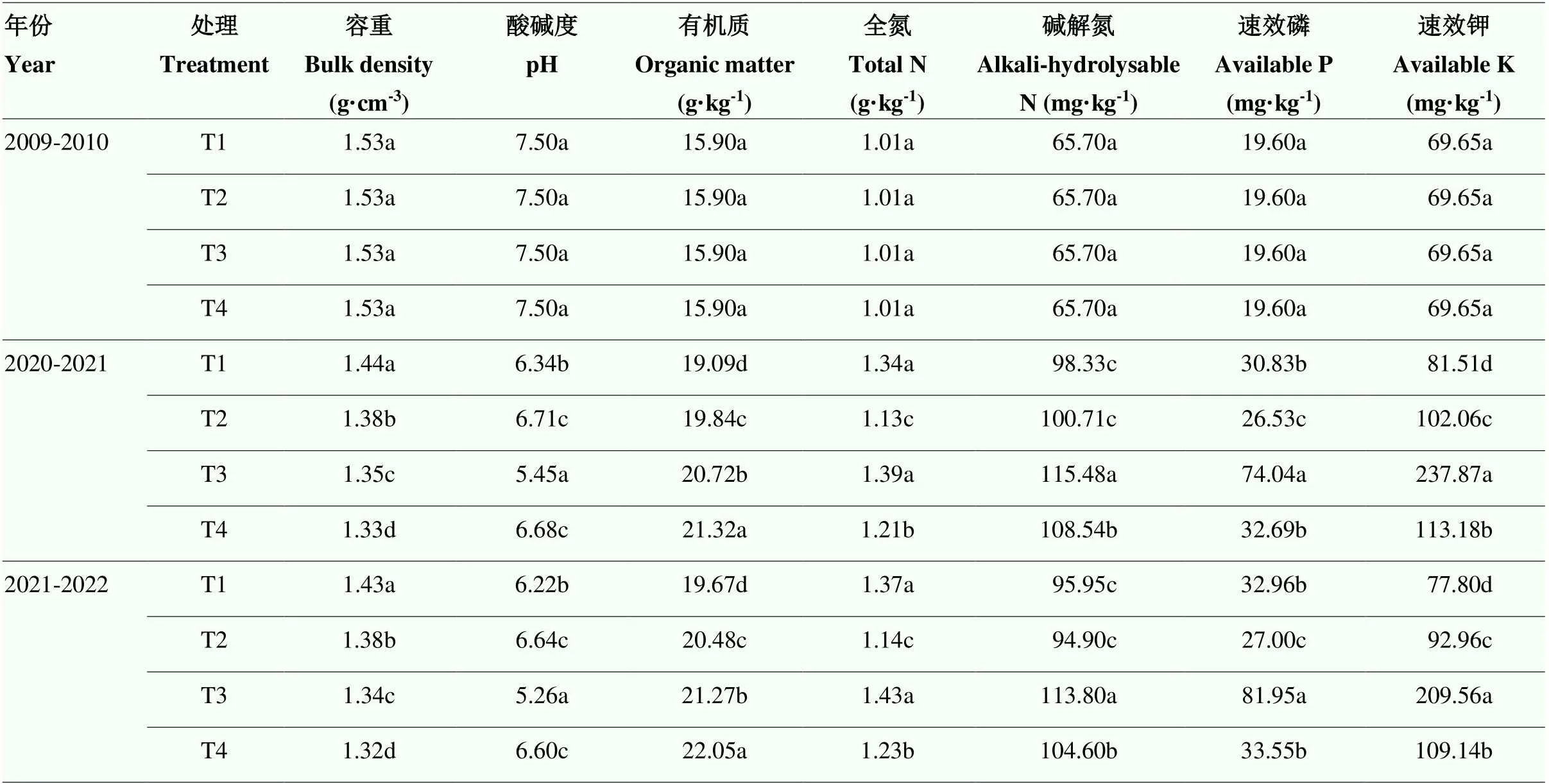
表2 栽培模式对冬小麦播前0—20 cm土层土壤理化性质的影响
多重比较仅在同一列和同一年份间进行,不同字母代表在<0.05水平上差异显著(n = 4)。下同
Values followed by the different letters within a column in the same year are significantly different at<0.05 level as determined by the LSD test (n = 4). The same as below
2.2 栽培模式对冬小麦播前0—100 cm土层无机氮积累量的影响
冬小麦播前0—100 cm土层无机氮积累量测定结果显示,2020—2022年生长季T1、T2、T3、T4模式两年均值分别为236.34、194.62、269.51和210.80 kg·hm-2,分别比2009—2010年生长季提高了33.96%、10.32%、52.77%和19.49%。与T1模式相比较,T2和T4模式分别低17.65%和10.81%,而T3模式高14.04%(图1)。
2.3 栽培模式对2020—2022年冬小麦氮素营养指数的影响
氮素营养指数常用来表征小麦植株氮素供需平衡状况,开花前一般基于地上部氮素积累量计算氮素营养指数。由表3可知,返青期各栽培模式的氮素营养指数均小于1,说明小麦植株处于氮素亏缺状态,各模式均需要补充氮肥。进入拔节期,T1模式已于返青期追施氮肥,T1和T3模式的氮素营养指数大于1,说明小麦植株处于氮素盈余状态。T2、T4模式的氮素营养指数小于1,说明小麦植株处于氮亏缺状态。拔节期追施氮肥后,开花期测定的氮素营养指数显示,T1、T2模式的氮素营养指数均小于1,小麦植株处于氮亏缺状态,其中T2模式的氮素亏缺较为严重。T4模式的氮素营养指数等于1,小麦植株氮素供需平衡,而T3模式的氮素营养指数大于1,小麦植株处于氮素盈余状态。分析基于穗部氮素积累计算的氮素营养指数(开花期-成熟期)可知,随着花前营养器官中贮藏氮素和花后吸收氮素源源不断地向穗部转运,各栽培模式的氮素营养指数均逐渐提高,到成熟期,T3模式的氮素营养指数大于1,处于氮素盈余状态,T4模式的氮素营养指数等于1,氮素供需平衡,T1、T2模式的氮素营养指数均小于1,均处于氮素亏缺状态,其中T1模式的氮素亏缺更为严重。
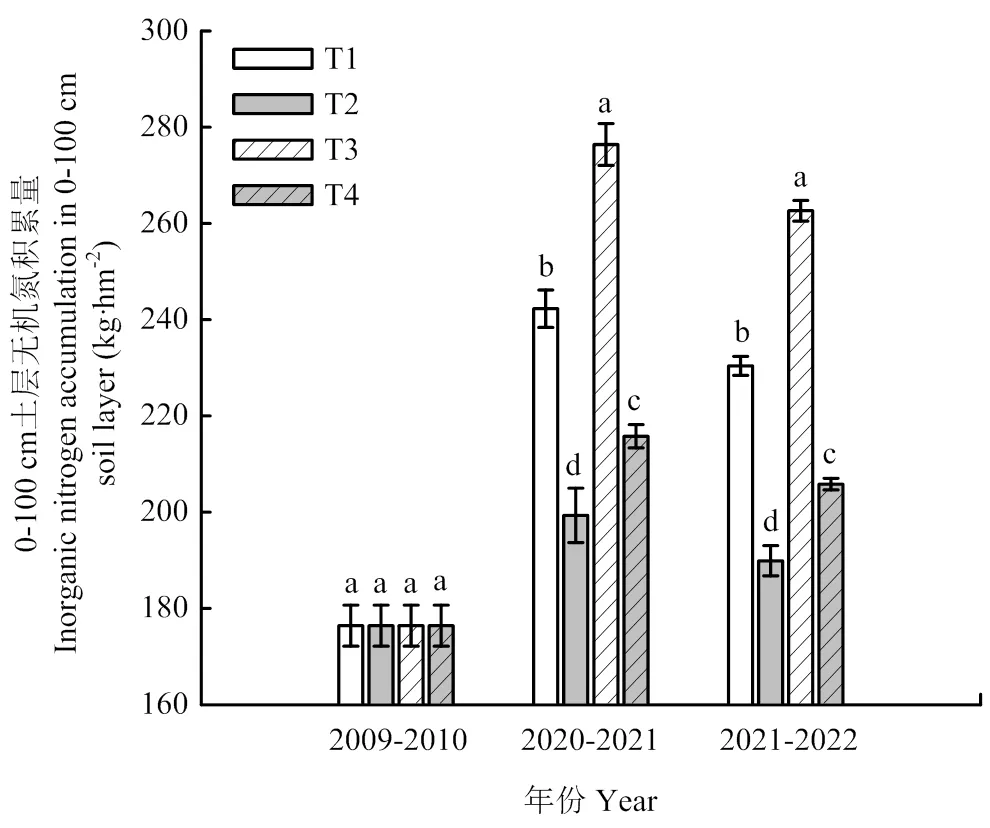
误差线表示4次重复的标准差。多重比较仅在同一年份间进行,不同字母代表在P<0.05水平上差异显著(n = 4)
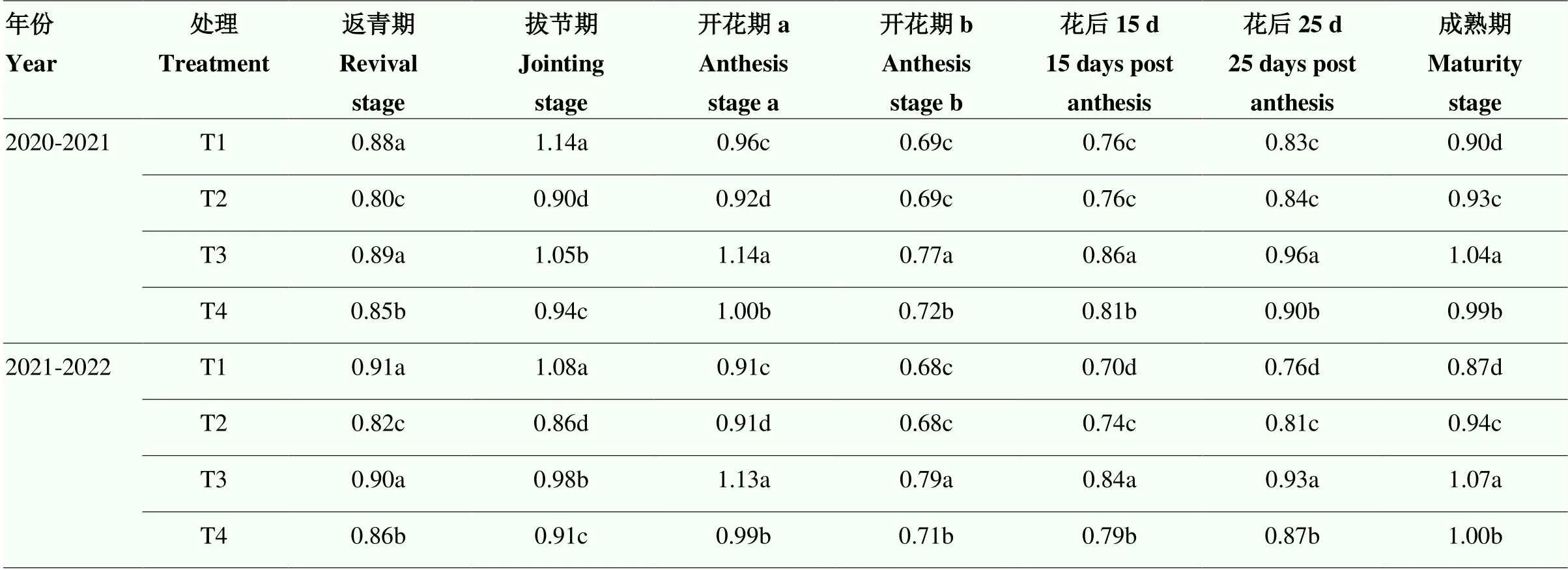
表3 栽培模式对2020—2022年冬小麦生育期氮素营养指数的影响
返青期至开花期a采用公式2计算氮素营养指数;开花期b至成熟期采用公式3计算氮素营养指数
Nitrogen nutrient index formula 2 is used from revival stage to anthesis stage a; Nitrogen nutrient index formula 3 is used from anthesis stage b to maturity stage
2.4 栽培模式对2020—2022年冬小麦籽粒产量和氮素吸收利用的影响
如表4所示,2个生长季的籽粒产量均表现为T3>T4>T2>T1,其中T2、T3、T4模式分别比T1模式提高14.14%、27.65%和22.52%。与籽粒产量有所不同,2个生长季的氮素利用率均表现为T2>T4>T3>T1,其中T2、T3、T4模式分别比T1模式提高54.80%、19.97%和49.15%。2个生长季的氮素吸收效率均表现为T2=T4>T3>T1,其中T2、T3、T4模式分别比T1模式提高43.17%、25.93%和43.91%。2个生长季的氮素内在利用效率有所差异,2020—2021年表现为T2>T1=T4>T3,而2021—2022年表现为T2>T4>T1>T3,其中T2、T4模式分别比T1模式提高8.12%和3.64%,T3模式比T1模式降低了4.73%。2个生长季的氮肥利用率均表现为T2>T4>T3>T1,其中T2、T3、T4模式分别比T1模式提高72.95%、37.54%和48.15%。
2.5 栽培模式对2020—2022年冬小麦生长季氮素供需平衡的影响
由表5可知,2020—2022年冬小麦生长季土壤氮净矿化量表现为T3模式最高,T4模式次之,T1和T2模式最低。播前土壤无机氮起始量表现为T3>T1>T4>T2。植株吸氮量则表现为T3>T4>T2>T1。2个生长季土壤无机氮起始量与土壤氮净矿化量之和高达290.43—406.98 kg·hm-2,已经远超过小麦植株吸氮量(209.36—285.20 kg·hm-2)。
受施氮量、播前土壤无机氮起始量、生长季内土壤净矿化量和小麦植株吸氮量的影响,不同模式的氮残留量差异显著,2个生长季均表现为T3>T1>T4>T2,其中T3模式比T1模式增加4.96%,T2和T4模式比T1模式减少25.36%和15.51%。2个生长季氮素表观损失量均表现为T1>T3>T4>T2,其中T2、T3和T4模式分别比T1模式降低49.76%、11.62%和44.14%。2个生长季氮素表观损失率表现为T1模式最高,T3模式次之,T2和T4模式最低,其中T2、T3和T4模式分别比T1模式降低24.63%、11.62%、26.68%。
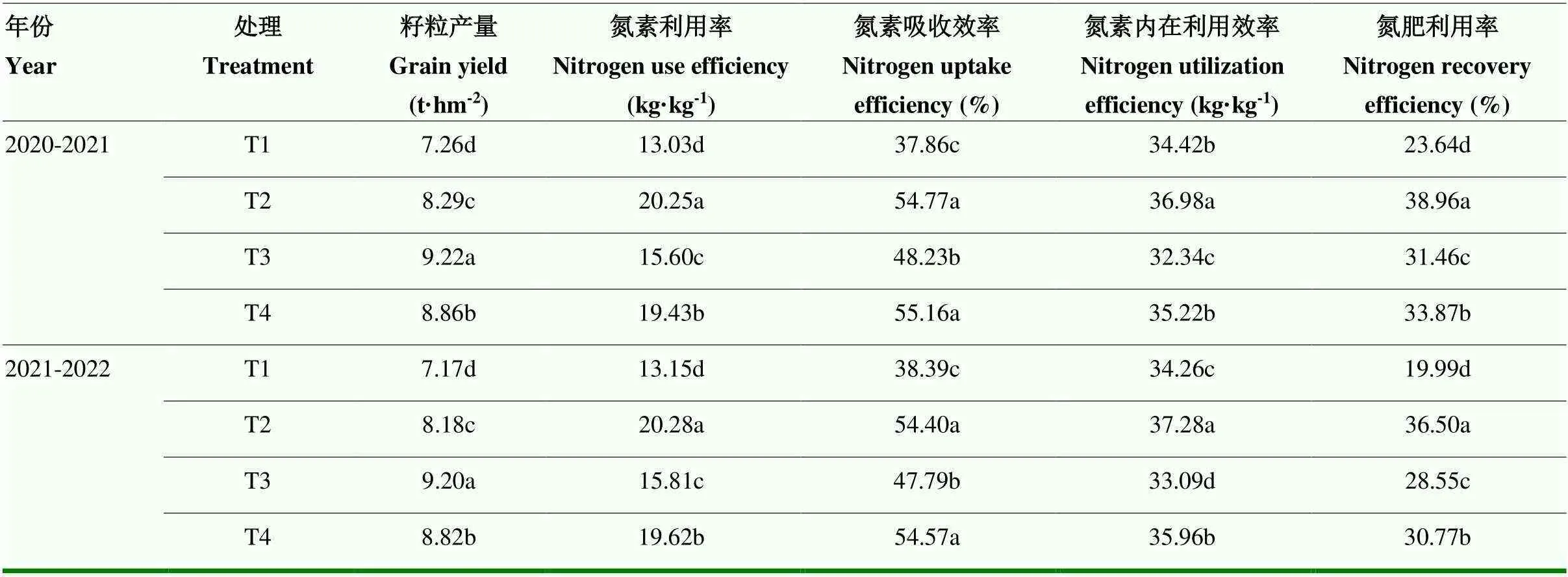
表4 栽培模式对2020—2022年冬小麦籽粒产量和氮素吸收利用的影响

表5 栽培模式对2020—2022年冬小麦生育期氮素供需平衡的影响
3 讨论
3.1 栽培模式对土壤理化性质的影响
土壤理化性质受种植年限、施肥量、秸秆还田、耕作措施等多重因素的影响。前人研究表明,长期氮磷钾配施有机肥能够提高土壤的有机质、全氮及速效养分的含量[24-26]。秸秆还田配合深耕不仅增加耕层厚度、降低土壤容重且增加土壤速效养分,改善土壤质量[27-29]。本研究表明,历经13个小麦-玉米生长季后,各模式0—20 cm的土壤容重均有所降低,且该土层的有机质、全氮、速效养分含量和0—100 cm的无机氮积累量均有所提高,与此同时,各模式0—20 cm土层土壤的pH均出现明显的酸化趋势,且各模式的土壤理化性质差异显著。历经13个小麦-玉米生长季后的土壤容重表现为T1>T2>T3>T4。秸秆还田量和耕作方式的不同应是导致模式间土壤容重存在差异的主要原因。秸秆还田量可通过影响土壤有机质含量进而影响土壤容重[30-31]。4种模式中T3模式的秸秆还田量最高,T4模式次之,T1模式最低[15,17]。另外,T1模式长期采取玉米季免耕+小麦季旋耕的耕作方式,使得秸秆积累存留在0—10 cm的土壤中[32-34],其他模式长期采取玉米季旋耕+小麦季深耕的耕作方式,有利于打破犁底层,秸秆深埋和降低土壤容重。土壤有机质的积累受碳输入量和输出量的共同影响[35-36]。长期和适量秸秆还田有利于土壤有机质含量的提高[37-41]。大量施氮则会导致土壤C﹕N比下降,土壤微生物活性、土壤呼吸和碳循环相关酶活性提高,有机质分解加快、含量降低[42-45]。施氮量与秸秆还田量失衡引起的土壤C﹕N比下降和有机质分解加快应是T3模式秸秆还田量最大但有机质含量低于T4模式的原因,同时也解释了为何T3模式的土壤容重高于T4模式。秸秆还田量低且施氮量与秸秆还田量失衡的共同作用使得T1模式的土壤有机质含量最低。长期大量施用氮肥会引起土壤中H+积累并加速耕地的酸化速率[46-47]。较高的氮肥总投入量应是T1和T3模式土壤酸化程度高于其他两个模式的主要原因。正是由于T3模式氮肥总投入量最高,其酸化程度也最严重。全氮和速效养分含量的增加主要与肥料投入盈余积累和土壤的矿化量有关[48-50]。周年肥料投入量、秸秆还田量和矿化量均高于其他模式应是T3模式土壤全氮和速效养分含量最高的原因。较高的秸秆还田量和矿化量则使得T4模式的土壤速效养分含量高于T1和T2模式,但较低施氮量和较高作物吸收量的结合导致其土壤全氮含量不仅低于T3模式也低于T1模式。低的氮肥、磷肥总投入量使得T2模式的土壤全氮含量和土壤速效磷含量最低。T1模式则因低秸秆还田量和钾肥总投入量表现出最低的土壤速效钾含量。0—100 cm土层的无机氮积累量随施氮量的增加而增加[51]。较高的氮肥总投入量应是T1和T3模式0—100 cm土层无机氮积累量高于其他两个模式的主要原因。T3模式与T1模式比较,因其氮肥总投入量更高,0—100 cm土层中无机氮积累量也最高。
3.2 栽培模式对冬小麦氮素吸收利用的影响
优化氮肥供应与作物植株氮素需求的匹配程度能够减少氮素损失[52-54]。前人研究表明,减少施氮量、增加追肥比例、采用缓/控释氮肥可以降低氮素表观损失量[55-57],而秸秆还田条件下配施氮肥会增加氮素的表观损失量[58-59]。T1与T3模式的氮素表观损失量显著高于其他模式,共性原因可能在于夏玉米季结束后土壤中大量的残留无机氮和冬小麦季生育期间较高的施氮量。T1模式较低的吸氮量和T3模式较高的氮矿化量进一步强化了这种氮素供应过量,导致土壤无机氮超出了作物吸收和土壤及微生物固持氮的极限,冗余的氮素“溢出”土壤-作物系统[51,60]。反观T4模式,其氮素表观损失量超过85 kg·hm-2,氮肥利用率也只有32.24%。与T2模式相比较可知,降低施氮量可在显著降低氮素表观损失量的同时,提高氮肥利用率。但氮素营养指数和产量数据表明,降低施氮量会导致小麦植株氮素供应不足,产量降低。因此,对于T4模式而言,仅通过降低施氮量无法实现产量和氮素吸收利用的进一步协同优化。在现有基础上进一步提高产量和氮肥吸收利用水平,应综合考虑选用氮高效品种、采用水肥一体化运筹方式、分层施肥、缓控释肥应用、小麦-玉米周年养分统筹等改进措施。
4 结论
历经13个小麦-玉米生长季后,4个栽培模式的土壤理化性质呈现相似的变化趋势,即表层土壤容重降低,表层土壤有机质、全氮、速效氮磷钾养分含量及0—100 cm土层无机氮积累量提高,表层土壤呈现出明显的酸化趋势。其中,T3模式除全氮含量之外的上述指标变化幅度最大,表层土壤酸化最严重。在当前土壤肥力条件下,T3模式籽粒产量最高,T4模式的籽粒产量比T3模式降低4.02%,但氮肥与氮素利用率分别提高7.72%和24.32%。然而,T4模式的氮素表观损失量仍居高位,氮肥利用率仍偏低。如何在T4模式基础上实现籽粒产量和氮素高效利用的进一步协同改善,有待进一步研究。
[1] CHEN X P, CUI Z L, VITOUSEK P M, CASSMAN K G, MATSON P A, BAI J S, MENG Q F, HOU P, YUE S C, ROEMHELD V, ZHANG F S. Integrated soil-crop system management for food security. Proceedings of the National Academy of Sciences of the United States of America, 2011, 108(16): 6399-6404.
[2] CHEN X P, CUI Z L, FAN M S, VITOUSEK P, ZHAO M, MA W Q, WANG Z L, ZHANG W J, YAN X Y, YANG J C, DENG X P, GAO Q, ZHANG Q, GUO S W, REN J, LI S Q, YE Y L, WANG Z H, HUANG J L, TANG Q Y, SUN Y X, PENG X L, ZHANG J W, HE M R, ZHU Y J, XUE J Q, WANG G L, WU L, AN N, WU L Q, MA L, ZHANG W F, ZHANG F S. Producing more grain with lower environmental costs. Nature, 2014, 514: 486-489.
[3] CUI Z L, DOU Z, YING H, ZHANG F S. Producing more with less: reducing environmental impacts through an integrated soil-crop system management approach. Frontiers of Agricultural Science and Engineering, 2020, 7(1): 14-20.
[4] 王树丽, 贺明荣, 代兴龙, 周晓虎. 种植密度对冬小麦氮素吸收利用和分配的影响. 中国生态农业学报, 2012, 20(10): 1276-1281.
WANG S L, HE M R, DAI X L, ZHOU X H. Effect of planting density on nitrogen uptake, utilization and distribution in winter wheat. Chinese Journal Eco-Agriculture, 2012, 20(10): 1276-1281. (in Chinese)
[5] DAI X L, ZHOU X H, JIA D Y, XIAO L L, HE M R. Managing the seeding rate to improve nitrogen-use efficiency of winter wheat. Field Crops Research, 2013, 154(3): 100-109.
[6] ZHANG Y, DAI X L, JIA D Y, LI H Y, WANG Y C, LI C X, XU H C, HE M R. Effects of plant density on grain yield, protein size distribution, and breadmaking quality of winter wheat grown under two nitrogen fertilisation rates. European Journal of Agronomy, 2016, 73: 1-10.
[7] DAI X L, WANG Y C, DONG X C, QIAN T F, YIN L J, DONG S X, CHU J P, HE M R. Delayed sowing can increase lodging resistance while maintaining grain yield and nitrogen use efficiency in winter wheat. The Crop Journal, 2017, 5(6): 541-552.
[8] YIN L J, DAI X L, HE M R. Delayed sowing improves nitrogen utilization efficiency in winter wheat without impacting yield. Field Crops Research, 2018, 221: 90-97.
[9] 朱元刚, 初金鹏, 张秀, 钤太峰, 代兴龙, 贺明荣. 不同播期冬小麦氮素出籽效率与氮素利用及转运的相关性. 应用生态学报, 2019, 30(4): 1151-1160.
ZHU Y G, CHU J P, ZHANG X, QIAN T F, DAI X L, HE M R. Correlation between nitrogen fruiting efficiency and nitrogen utilization and remobilization in winter wheat at different sowing dates. Chinese Journal of Applied Ecology, 2019, 30(4): 1151-1160. (in Chinese)
[10] 郑飞娜, 初金鹏, 张秀, 费立伟, 代兴龙, 贺明荣. 播种方式与种植密度互作对大穗型小麦品种产量和氮素利用率的调控效应. 作物学报, 2020, 46(3): 423-431.
ZHENG F N, CHU J P, ZHANG X, FEI L W, DAI X L, HE M R. Interactive effects of sowing pattern and planting density on grain yield and nitrogen use efficiency in large spike wheat cultivar. Acta Agronomica Sinica, 2020, 46(3): 423-431. (in Chinese)
[11] 刘运景, 郑飞娜, 张秀, 初金鹏, 于海涛, 代兴龙, 贺明荣. 宽幅播种对强筋小麦籽粒产量、品质和氮素吸收利用的影响. 作物学报, 2022, 48(3): 716-725.
LIU Y J, ZHENG F N, ZHANG X, CHU J P, YU H T, DAI X L, HE M R. Effects of wide range sowing on grain yield, quality, and nitrogen use of strong gluten wheat. Acta Agronomica Sinica, 2022, 48(3): 716-725. (in Chinese)
[12] LI Z J, HU K L, LI B G, HE M R, ZHANG J W. Evaluation of water and nitrogen use efficiencies in a double cropping system under different integrated management practices based on a model approach. Agricultural Water Management, 2015, 159: 19-34.
[13] 王月超, 李传兴, 代兴龙, 周晓燕, 张宇, 李华英, 贺明荣. 栽培模式对冬小麦光能利用和产量的影响. 应用生态学报, 2015, 26(9): 2707-2713.
WANG Y C, LI C X, DAI X L, ZHOU X Y, ZHANG Y, LI H Y, HE M R. Effects of cultivation patterns on the radiation use and grain yield of winter wheat. Chinese Journal of Applied Ecology, 2015, 26(9): 2707-2713. (in Chinese)
[14] 马鑫, 代兴龙, 王晓婧, 董述鑫, 王月超, 徐海成, 朱元刚, 贺明荣. 冬小麦高产高效群体的年际间稳产性能. 应用生态学报, 2017, 28(12): 3926-3934.
MA X, DAI X L, WANG X J, DONG S X, WANG Y C, XU H C, ZHU Y G, HE M R. Stability of a winter wheat population with high yield and high resource use efficiency. Chinese Journal of Applied Ecology, 2017, 28(12): 3926-3934. (in Chinese)
[15] XU H C, DAI X L, CHU J P, WANG Y C, YIN L J, MA X, DONG S X, HE M R. Integrated management strategy for improving the grain yield and nitrogen-use efficiency of winter wheat. Journal of Integrative Agriculture, 2018, 17(2): 315-327.
[16] CHENG Y, DAI X L, FENG H, WANG Y C, LIU P, HE M R. Precision double cropping synergistically improves wheat and maize yields as well as resource efficiency. Agronomy Journal, 2020, 112(2): 1035-1048.
[17] LIU Z, GAO J, GAO F, DONG S T, LIU P, ZHAO B, ZHANG J W. Integrated agronomic practices management improve yield and nitrogen balance in double cropping of winter wheat-summer maize. Field Crops Research, 2018, 221: 196-206.
[18] 鲁如坤. 土壤农业化学分析方法. 北京: 中国农业科技出版社, 2000.
LU R K. Soil Agrochemical Analysis Methods. Beijing: China Agricultural Science and Technology Publishers, 2000. (in Chinese)
[19] 刘学军, 赵紫娟, 巨晓棠, 张福锁. 基施氮肥对冬小麦产量、氮肥利用率及氮平衡的影响. 生态学报, 2002, 22(7): 1122-1128.
LIU X J, ZHAO Z J, JU X T, ZHANG F S. Effect of N application as basal fertilizer on grain yield of winter wheat, fertilizer N recovery and N balance. Acta Ecologica Sinica, 2002, 22(7): 1122-1128. (in Chinese)
[20] 初金鹏, 朱文美, 尹立俊, 石玉华, 邓淑珍, 张良, 贺明荣, 代兴龙. 宽幅播种对冬小麦‘泰农18’产量和氮素利用率的影响. 应用生态学报, 2018, 29(8): 2517-2524.
CHU J P, ZHU W M, YIN L J, SHI Y H, DENG S Z, ZHANG L, HE M R, DAI X L. Effects of wide-range planting on the yield and nitrogen use efficiency of winter wheat cultivar Tainong 18. Chinese Journal of Applied Ecology, 2018, 29(8): 2517-2524. (in Chinese)
[21] LEMAIRE G, JEUFFROY M H, GASTAL F. Diagnosis tool for plant and crop N status in vegetative stage. Theory and practices for crop N management. European Journal of Agronomy, 2008, 28(4): 614-624.
[22] JUSTES E, MARY B, MEYNARD J M, MACHET J M, THELIER- HUCHE L. Determination of a critical nitrogen dilution curve for winter wheat crops. Annals of Botany, 1994, 74: 397-407.
[23] ZHAO B, NIU X L, ATA-UL-KARIM S T, WANG L G, DUAN A W, LIU Z D, LEMAIRE G. Determination of the post-anthesis nitrogen status using ear critical nitrogen dilution curve and its implications for nitrogen management in maize and wheat. European Journal of Agronomy, 2020, 113: 125967.
[24] 林治安, 赵秉强, 袁亮, HWAT B S. 长期定位施肥对土壤养分与作物产量的影响. 中国农业科学, 2009, 42(8): 2809-2819.
LIN Z A, ZHAO B Q, YUAN L, HWAT B S. Effects of organic manure and fertilizers long-term located application on soil fertility and crop yield. Scientia Agricultura Sinica, 2009, 42(8): 2809-2819. (in Chinese)
[25] 魏猛, 张爱君, 诸葛玉平, 李洪民, 唐忠厚, 陈晓光. 长期不同施肥对黄潮土区冬小麦产量及土壤养分的影响. 植物营养与肥料学报, 2017, 23(2): 304-312.
WEI M, ZHANG A J, ZHUGE Y P, LI H M, TANG Z H, CHEN X G. Effect of different long-term fertilization on winter wheat yield and soil nutrient contents in yellow fluvo-aquic soil area. Journal of Plant Nutrition and Fertilizers, 2017, 23(2): 304-312. (in Chinese)
[26] THAKUR A, SHARMA R P, SANKHYAN N K, SEPEHYA S. Effect of 46 years’ application of fertilizers, FYM and lime on physical, chemical and biological properties of soil under maize-wheat system in an acid Alfisol of northwest Himalayas. Soil Use and Management, 2023, 39: 357-367.
[27] LIU C, LU M, CUI J, LI B, FANG C M. Effects of straw carbon input on carbon dynamics in agricultural soils: a meta-analysis. Global Change Biology, 2014, 20: 1366-1381.
[28] 韩上, 武际, 李敏, 陈峰, 王允青, 程文龙, 唐杉, 王慧, 郭熙盛, 卢昌艾. 深耕结合秸秆还田提高作物产量并改善耕层薄化土壤理化性质. 植物营养与肥料学报, 2020, 26(2): 276-284.
HAN S, WU J, LI M, CHEN F, WANG Y Q, CHENG W L, TANG S, WANG H, GUO X S, LU C A. Deep tillage with straw returning increase crop yield and improve soil physicochemical properties under topsoil thinning treatment. Journal of Plant Nutrition and Fertilizers, 2020, 26(2): 276-284. (in Chinese)
[29] CUI H X, LUO Y L, CHEN J, JIN M, LI Y, WANG Z L. Straw return strategies to improve soil properties and crop productivity in a winter wheat-summer maize cropping system. European Journal of Agronomy, 2022, 133: 126436.
[30] 李冬初, 黄晶, 马常宝, 薛彦东, 高菊生, 王伯仁, 张杨珠, 柳开楼, 韩天富, 张会民. 中国农耕区土壤有机质含量及其与酸碱度和容重关系. 水土保持学报, 2020, 34(6): 252-258.
LI D C, HUANG J, MA C B, XUE Y D, GAO J S, WANG B R, ZHANG Y Z, LIU K L, HAN T F, ZHANG H M. Soil organic matter content and its relationship with pH and bulk density in agricultural areas of China. Journal of Soil and Water Conservation, 2020, 34(6): 252-258. (in Chinese)
[31] XU X, PANG D W, CHEN J, LUO Y L, ZHENG M J, YIN Y P, LI Y X, LI Y, WANG Z L. Straw return accompany with low nitrogen moderately promoted deep root. Field Crops Research, 2018, 221: 71-80.
[32] GUAN D H, ZHANG Y S, AL-KAISI M M, WANG Q Y, ZHANG M C, LI Z H. Tillage practices effect on root distribution and water use efficiency of winter wheat under rain-fed condition in the North China Plain. Soil and Tillage Research, 2015, 146: 286-295.
[33] MEURER K H E, HADDAWAY N R, BOLINDER M A, KÄTTERER T. Tillage intensity affects total SOC stocks in boreo- temperate regions only in the topsoil—A systematic review using an ESM approach. Earth-Science Reviews, 2018, 177: 613-622.
[34] ZHAO J H, LIU Z, LAI H J, YANG D Q, LI X D. Optimizing residue and tillage management practices to improve soil carbon sequestration in a wheat-peanut rotation system. Journal of Environmental Management, 2022, 306: 114468.
[35] YANG X Y, REN W D, SUN B H, ZHANG S L. Effects of contrasting soil management regimes on total and labile soil organic carbon fractions in a loess soil in China. Geoderma, 2012, 177/178: 49-56.
[36] ZHANG S X, LI Q, XIAO X P, WEI K, CHEN L J, LIANG W J. Effects of conservation tillage on soil aggregation and aggregate binding agents in black soil of Northeast China. Soil and Tillage Research, 2012, 124: 196-202.
[37] LI Z, LI D, LEI M, YU Y, ZHAO B, ZHANG J. Effects of straw management and nitrogen application rate on soil organic matter fractions and microbial properties in North China Plain. Journal of Soils and Sediments, 2019, 19: 618-628.
[38] HAO X X, HAN X Z, WANG S Y, LI L J. Dynamics and composition of soil organic carbon in response to 15 years of straw return in a Mollisol. Soil and Tillage Research, 2022, 215: 105221.
[39] CAO B B, QU C Y, GUO Y Y, LIU C H, LIANG Z Y, JIAO Y P, SHI J L, TIAN X H. Long-term nitrogen and straw application improves wheat production and soil organic carbon sequestration. Journal of Soil Science and Plant Nutrition, 2022, 22: 3364-3376.
[40] ZHAO H L, SHAR A G, LI S, CHEN Y L, SHI J L, ZHANG X Y, TIAN X H. Effect of straw return mode on soil aggregation and aggregate carbon content in an annual maize-wheat double cropping system. Soil and Tillage Research, 2018, 175: 178-186.
[41] ZHU L Q, HU N J, ZHANG Z W, XU J L, TAO B, MENG Y L. Short-term responses of soil organic carbon and carbon pool management index to different annual straw return rates in a rice-wheat cropping system. Catena, 2015, 135: 283-289.
[42] LU M, ZHOU X H, LUO Y Q, YANG Y H, FANG C M, CHEN J K, LI B. Minor stimulation of soil carbon storage by nitrogen addition: A meta-analysis. Agriculture, Ecosystems and Environment, 2011, 140(1): 234-244.
[43] 杨苏, 刘耀武, 章欢, 李辉信, 张永春, 艾玉春, 汪吉东. 土壤不同形态碳氮含量和酶活性对培养时间及外源碳投入的响应. 水土保持学报, 2020, 34(4): 340-346.
YANG S, LIU Y W, ZHANG H, LI H X, ZHANG Y C, AI Y C, WANG J D. Responses of different forms of soil carbon and nitrogen contents and enzyme activities to cultivation time and exogenous carbon input. Journal of Soil and Water Conservation, 2020, 34(4): 340-346. (in Chinese)
[44] DAI X L, ZHOU W, LIU G R, LIANG G Q, HE P, LIU Z B. Soil C/N and pH together as a comprehensive indicator for evaluating the effects oforganic substitution management in subtropical paddy fields after application of high-quality amendments. Geoderma, 2019, 337: 1116-1125.
[45] ZHANG H Y, NIU L A, HU K L, HAO J M, LI F, WANG X, CHEN H. Long-term effects of nitrogen and phosphorus fertilization on soil aggregate stability and aggregate-associated carbon and nitrogen in the North China Plain. Soil Science Society of America Journal, 2021, 85(3): 732-745.
[46] GUO J H, LIU X J, ZHANG Y, SHEN J L, HAN W X, ZHANG W F, CHRISTIE P, GOULDING K, VITOUSEK P M, ZHANG F S. Significant acidification in major Chinese croplands. Science, 2010, 327(5968): 1008-1010.
[47] HUANG P, ZHANG J B, XIN X L, ZHU A N, ZHANG C Z, MA D H, ZHU Q G, YANG S, WU S J. Proton accumulation accelerated by heavy chemical nitrogen fertilization and its long-term impact on acidifying rate in a typical arable soil in the Huang-Huai-Hai Plain. Journal of Integrative Agriculture, 2015, 14(1): 148-157.
[48] LI J G, WAN X, LIU X X, CHEN Y, SLAUGHTER L C, WEINDORF D C, DONG Y H. Changes in soil physical and chemical characteristics in intensively cultivated greenhouse vegetable fields in North China. Soil and Tillage Research, 2019, 195: 104366.
[49] ŠIMANSKÝ V, JONCZAK J, HORVÁTHOVÁ J, IGAZ D, AYDIN E, KOVÁČIK P. Does long-term application of mineral fertilizers improve physical properties and nutrient regime of sandy soils?. Soil and Tillage Research, 2022, 215: 105224.
[50] HE M Q, XIN X L, MENG L, YAN X Y, ZHAO C, CAI Z C, ZHU A N, ZHANG J B, MÜLLER C. Long-term appropriate N management can continuously enhance gross N mineralization rates and crop yields in a maize-wheat rotation system. Biology and Fertility of Soils, 2021, doi: 10.1007/s00374-021-01595-9.
[51] 王东, 于振文, 于文明, 石玉, 周忠新. 施氮水平对高产麦田土壤硝态氮时空变化及氨挥发的影响. 应用生态学报, 2006, 17(9): 1593-1598.
WANG D, YU Z W, YU W M, SHI Y, ZHOU Z X. Effect of nitrogen application level on soil nitrate accumulation and ammonia volatilization in high-yielding wheat field. Chinese Journal of Applied Ecology, 2006, 17(9): 1593-1598. (in Chinese)
[52] 马兴华, 于振文, 梁晓芳, 颜红, 史桂萍. 施氮量和底追比例对小麦氮素利用和土壤硝态氮含量的影响. 水土保持学报, 2006, 20(5): 95-98.
MA X H, YU Z W, LIANG X F, YAN H, SHI G P. Effects of nitrogen application rate and ratio of base and topdressing on nitrogen utilization and soil NO3-N content in winter wheat. Journal of Soil and Water Conservation, 2006, 20(5): 95-98. (in Chinese)
[53] 崔振岭, 陈新平, 张福锁, 徐久飞, 石立委, 李俊良. 华北平原冬小麦/夏玉米轮作体系土壤硝态氮的适宜含量. 应用生态学报, 2007, 18(10): 2227-2232.
CUI Z L, CHEN X P, ZHANG F S, XU J F, SHI L W, LI J L. Appropriate soil nitrate N content for a winter wheat/summer maize rotation system in North China Plain. Chinese Journal of Applied Ecology, 2007, 18(10): 2227-2232. (in Chinese)
[54] DHILLON J, EICKHOFF E, AULA L, OMARA P, WEYMEYER G, NAMBI E, OYEBIYI F, CARPENTER T, RAUN W. Nitrogen management impact on winter wheat grain yield and estimated plant nitrogen loss. Agronomy Journal, 2020, 112(1): 564-577.
[55] 郭天财, 宋晓, 冯伟, 马冬云, 谢迎新, 王永华. 高产麦田氮素利用、氮平衡及适宜施氮量. 作物学报, 2008, 34(5): 886-892.
GUO T C, SONG X, FENG W, MA D Y, XIE Y X, WANG Y H. Utilization and balance of nitrogen and proper application amount of nitrogen fertilizer in winter wheat in high-yielding regions. Acta Agronomica Sinica, 2008, 34(5): 886-892. (in Chinese)
[56] SHI Z L, LI D D, JING Q, CAI J, JIANG D, CAO W X, DAI T B. Effects of nitrogen applications on soil nitrogen balance and nitrogen utilization of winter wheat in a rice-wheat rotation. Field Crops Research, 2012, 127: 241-247.
[57] 赵营, 刘晓彤, 罗健航, 赵天成, 张学军. 缓/控释肥条施对春玉米产量、吸氮量与氮平衡的影响. 中国土壤与肥料, 2020(5): 34-39.
ZHAO Y, LIU X T, LUO J H, ZHAO T C, ZHANG X J. Yield, N uptake, and apparent N balance in spring maize as affected by side bar application of slow/controlled release fertilizers. Soils and Fertilizers Sciences in China, 2020(5): 34-39. (in Chinese)
[58] 李玮, 乔玉强, 陈欢, 曹承富, 杜世州, 赵竹. 玉米秸秆还田配施氮肥对冬小麦土壤氮素表观盈亏及产量的影响. 植物营养与肥料学报, 2015, 21(3): 561-570.
LI W, QIAO Y Q, CHEN H, CAO C F, DU S Z, ZHAO Z. Effects of combined maize straw and N application on soil nitrogen surplus amount and yield of winter wheat. Journal of Plant Nutrition and Fertilizer, 2015, 21(3): 561-570. (in Chinese)
[59] 王新媛, 赵思达, 郑险峰, 王朝辉, 何刚. 秸秆还田和氮肥用量对冬小麦产量和氮素利用的影响. 中国农业科学, 2021, 54(23): 5043-5053.
WANG X Y, ZHAO S D, ZHENG X F, WANG Z H, HE G. Effects of straw returning and nitrogen application rate on grain yield and nitrogen utilization of winter wheat. Scientia Agricultura Sinica, 2021, 54(23): 5043-5053. (in Chinese)
[60] 杨宪龙, 路永莉, 同延安, 林文, 梁婷. 长期施氮和秸秆还田对小麦-玉米轮作体系土壤氮素平衡的影响. 植物营养与肥料学报, 2013, 19(1): 65-73.
YANG X L, LU Y L, TONG Y A, LIN W, LIANG T. Effects of long-term N application and straw returning on N budget under wheat-maize rotation system. Journal of Plant Nutrition and Fertilizer, 2013, 19(1): 65-73. (in Chinese)
Effects of Cultivation Modes on Soil physicochemical Properties and Nitrogen Balance in Wheat Fields under Long-Term Positioning Conditions
GUO XinHu1, MA Jing1, LI ZhongFeng1, CHU JinPeng1, XU HaiCheng2, JIA DianYong3, DAI XingLong1, HE MingRong1
1College of Agronomy, Shandong Agricultural University/State Key Laboratory of Crop Biology/Key Laboratory of Crop Ecophysiology and Farming System, Ministry of Agriculture and Rural Affairs, Taian 271018, Shandong;2Weifang University of Science and Technology, Weifang 262799, Shandong;3Nanyang Normal University, Nanyang 473061, Henan
【Objective】From the 2009-2010 wheat growing season, four cultivation modes were designed and set up. The effects of cultivation modes on soil physical and chemical properties, nitrogen nutrition index of winter wheat, nitrogen supply and demand balance in wheat field, uptake and utilization of nitrogen and grain yield were investigated, in order to provide a theoretical guidance for further optimizing the soil-crop system integrated management mode.【Method】Four cultivation modes were designed: local farmer mode (T1), improvement mode based on farmers (T2), high-yield and higher-yield mode regardless of production cost (T3), and soil-crop system integrated management mode (T4).【Result】After 13 wheat-maize growing seasons, the soil bulk density of surface soil for T1, T2, T3 and T4 modes decreased by 6.21%, 9.80%, 12.25% and 13.56%, respectively; the content of organic matter for four modes increased by 21.88%, 26.80%, 32.05% and 36.39%, respectively; the corresponding increases were 34.16%, 12.38%, 39.60% and 20.79% for the contents of total nitrogen; 47.85%, 48.87%, 74.49% and 62.21% for the contents of alkali-hydrolysable nitrogen, respectively; 62.73%, 36.56%, 297.93% and 68.68% for the contents of available phosphorus; 14.36%, 40.00%, 221.20% and 59.60% for the contents of available potassium, respectively. The increases of 33.96%, 10.32%, 52.77% and 19.49% were observed in the inorganic nitrogen accumulation in the 0-100 cm soil layer, respectively. Correspondingly, the pH for T1, T2, T3 and T4 modes decreased from 7.50 to 6.28, 6.68, 5.35 and 6.64, respectively. There were significant differences in grain yield and nitrogen uptake and utilization among the four cultivation modes in 2020-2022 growing season. Compared with T1 mode, the grain yield of T2, T3 and T4 modes increased by 14.14%, 27.65% and 22.52%, respectively; the nitrogen use efficiency increased by 54.80%, 19.97% and 49.15%, respectively; the nitrogen recovery efficiency increased by 72.95%, 37.54% and 48.15%, respectively; the nitrogen surplus decreased by 49.76%, 11.62% and 44.14%, respectively; the nitrogen surplus rate decreased by 24.63%, 11.62% and 26.68%, respectively. The whole plant at anthesis stage and spikes at maturity stage under T4 mode were in nitrogen supply and demand balance.【Conclusion】After 13 wheat-maize growing seasons, the soil acidification trend of 0-20 cm was obvious, and the bulk density of surface soil decreased, but the contents of organic matter, total nitrogen and available nutrients such as nitrogen, phosphorus, potassium increased for the all four cultivation modes. Meanwhile, the accumulation of inorganic nitrogen in 0-100 cm soil layer increased accordingly. Compared with other three cultivation modes, a synergistic improvement was obtained under T4 mode in soil physicochemical properties, wheat grain yield and nitrogen use efficiency. However, the nitrogen use efficiency at present under T4 mode was not high enough and still needed to be further improved. As showed by present study, further synergistic optimization in grain yield and nitrogen use efficiency could not be achieved only by reducing nitrogen input.
soil physicochemical property; wheat grain yield; nitrogen use efficiency; nitrogen nutrition index; nitrogen balance

10.3864/j.issn.0578-1752.2023.12.003
2022-10-21;
2023-01-08
山东省重点研发计划(LJNY202103)、国家重点研发计划(2016YFD0300403)
郭鑫虎,E-mail:xinhuguo@163.com。通信作者代兴龙,E-mail:adaisdny@163.com。通信作者贺明荣,E-mail:mrhe@sdau.edu.cn
(责任编辑 杨鑫浩,岳梅)
